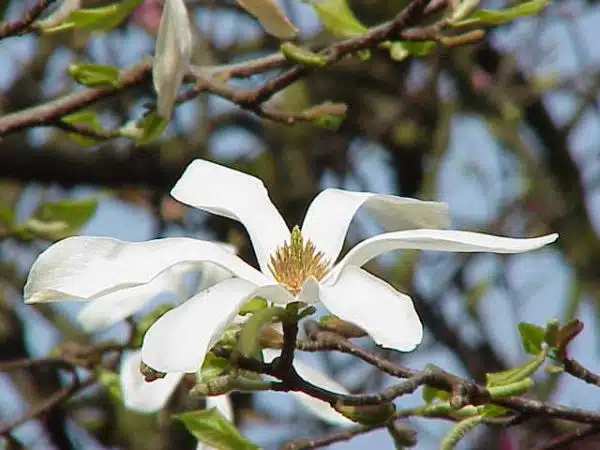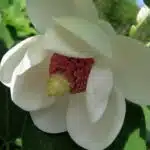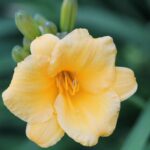The Kobus Magnolia, known for its delicate pink and white blossoms that appear in early spring, is a popular ornamental tree found in many gardens and landscaping projects. This deciduous tree belongs to the Magnoliaceae family, which includes other well-known species such as the Southern Magnolia and the Star Magnolia. With proper care and attention, the Kobus Magnolia can thrive in a variety of environments and add beauty to any landscape.
Growing a healthy and vibrant Kobus Magnolia requires an understanding of its unique needs. In this article, we will provide a comprehensive guide on how to care for and grow this beautiful tree. From selecting the right planting location to pruning techniques, we will cover everything you need to know to ensure your Kobus Magnolia thrives. Whether you are an experienced gardener or just starting out, our guide will equip you with the knowledge and tools necessary to create a stunning addition to your garden or landscape project.
Overview Of The Kobus Magnolia
The Kobus Magnolia is a deciduous tree that belongs to the Magnoliaceae family. It is native to Japan and Korea and can grow up to 30 feet tall with a spread of 20-25 feet. This tree blooms in early spring before its leaves emerge, producing large white or pink flowers that are fragrant and have a star-like shape.
One of the unique characteristics of the Kobus Magnolia is its ability to tolerate cold temperatures. It can survive in USDA hardiness zones 4-8, which makes it an ideal choice for gardeners who live in colder regions. Additionally, this tree prefers well-drained soil that is slightly acidic and requires full sun to partial shade.
Growing tips for the Kobus Magnolia include regular watering during dry periods, pruning after flowering to promote new growth, and fertilizing in early spring. This tree does not require heavy pruning but may need some shaping if it becomes too dense or unruly. With proper care, the Kobus Magnolia can provide years of beauty and enjoyment in any landscape.
When selecting the right planting location for your Kobus Magnolia, consider factors such as sunlight exposure, soil quality, and spacing requirements. These trees should be planted at least 10-15 feet apart from other trees or structures to allow for adequate growth space. Choosing a spot that receives morning sun and afternoon shade can help prevent heat stress on the tree during hot summer months.
Selecting The Right Planting Location
Overview of the Kobus Magnolia has provided you with all the important details about this beautiful plant. Now that you know what a Kobus Magnolia is and what it can offer, it’s time to choose the right location for planting it. The best location for planting a Kobus Magnolia is where it gets enough sunlight and shelter from harsh winds.
Site preparation is an essential factor in ensuring successful growth of your plant. You can start by testing your soil to determine its pH level and nutrient content. A pH level of around 6-7 is ideal for growing a Kobus Magnolia. If your soil test reveals a lower pH, consider adding lime to increase the alkalinity or sulfur to decrease it. Also, ensure that the soil is well-draining to avoid waterlogging.
When selecting a site for planting your Kobus Magnolia, consider the following:
Choose a spot that receives at least six hours of sunlight each day.
Look for an area that offers protection against strong winds, which could damage delicate branches and flowers.
Ensure that there is enough space around the tree so that its roots have room to grow and spread out.
As we move on to discussing soil and water requirements in the next section, keep in mind that proper site preparation will provide an excellent foundation for optimal growth of your Kobus Magnolia plant.
Soil And Water Requirements
While the Kobus Magnolia is an excellent choice for any garden, some may be hesitant to grow this plant due to its soil and water requirements. However, with a little bit of research and care, it can thrive in most gardens.
One important aspect of growing Kobus Magnolias is ensuring that they are planted in soil with an ideal pH level between 5.0 and 6.5. This acidic soil can be achieved by using peat moss or adding sulfur to the soil. It’s also important to ensure that the soil is well-draining, as waterlogged soil can result in root rot and other diseases.
When it comes to watering, the frequency will depend on factors such as climate, humidity levels, and rainfall. In general, young plants should be watered more frequently than established ones. Additionally, it’s best to water deeply but infrequently rather than giving the plant light frequent watering. Consistency is key when it comes to watering Kobus Magnolias.
Properly caring for soil and watering needs is crucial in ensuring a healthy and vibrant Kobus Magnolia garden. Next up, we will discuss the sunlight and temperature needs of this beautiful plant to help you further establish its ideal growing conditions.
Sunlight And Temperature Needs
The Kobus Magnolia is a hardy tree that can adapt to various climatic conditions. It prefers full sun exposure but can also tolerate partial shade. When grown indoors, it needs at least six hours of direct sunlight per day. In contrast, outdoor cultivation requires the plant to be exposed to full sun for optimal growth and blooming. Insufficient sunlight can cause the plant’s leaves to turn yellow, and its flowers may not bloom.
The Kobus Magnolia thrives in moderate temperatures ranging from 15°C to 25°C (59°F to 77°F). In winter, it goes dormant, and its leaves fall off; thus, it requires winter protection when grown outdoors in areas with harsh winters. Winter protection includes mulching the base of the tree with organic matter or wrapping its trunk with burlap cloth. When cultivating this species indoors during winter, maintain a temperature range of 10°C to 16°C (50°F to 61°F) for optimal growth.
To ensure your Kobus Magnolia grows healthily and blooms beautifully, you must provide it with ample sunlight and regulate its temperature throughout the year. Considering indoor cultivation or growing in areas with harsh winters will require adequate winter protection measures such as mulching and wrapping the tree trunk with burlap cloth. With proper care and attention given to these aspects of cultivation, your Kobus Magnolia will have an excellent foundation for healthy growth throughout its life span.
Transition: Now that we’ve covered sunlight and temperature needs let’s move on to fertilization and nutrient management- essential factors for maintaining healthy growth and stunning blooms in your Kobus Magnolia trees!
Fertilization And Nutrient Management
- When growing kobus magnolia, fertilizer should be applied to ensure the soil has the necessary nutrients for the tree to thrive.
- Available fertilizer types vary in their nutrient composition, and can include organic or synthetic, in granular, liquid, or slow-release forms.
- Fertilizer application should be done at the beginning of the growing season and repeated as needed throughout the season.
- Nutrient deficiencies can occur if the soil is not properly fertilized, leading to stunted growth and poor flowering.
- The best way to diagnose and treat nutrient deficiencies is to identify the specific nutrient that is lacking and supplement with the appropriate fertilizer.
- Regular soil testing can help to monitor soil nutrient levels to identify any potential deficiencies and ensure optimal tree growth.
Fertilizer Types
Taking care of a kobus magnolia requires attention to various factors, and one of the most important is fertilization. When it comes to choosing between organic or synthetic fertilizers, it is essential to consider the type of soil in which your kobus magnolia is growing. Organic fertilizers are made from natural sources such as compost and animal manure, which can help improve soil structure and provide slow-release nutrients over a more extended period. Synthetic fertilizers, on the other hand, are manufactured from chemicals and provide an immediate nutrient boost but can also lead to nutrient imbalances in the soil over time.
The timing of fertilizer application is another crucial factor when taking care of a kobus magnolia. Applying fertilizer at the right time helps ensure that your plant receives sufficient nutrients for healthy growth without causing any harm. It is best to apply fertilizer during the active growing season in early spring or late fall when the ground is soft and moist. Avoid fertilizing during periods of drought or excessively hot weather as this may cause damage to your plant.
In conclusion, choosing between organic or synthetic fertilizers for your kobus magnolia depends on your specific needs and preferences. Consider the type of soil you have and how much nutrients your plant requires before selecting a fertilizer option. Additionally, timing plays a significant role in ensuring that your plant receives adequate nutrition without causing any harm. With proper attention to these factors, you can help ensure that your kobus magnolia thrives and grows into a beautiful addition to any landscape design.
Fertilizer Application
Fertilization and nutrient management play a crucial role in the maintenance of a kobus magnolia. Among the essential factors to consider is the frequency of fertilizer application. Organic and chemical fertilizers can provide your plant with the necessary nutrients, but applying them at the right time is equally important.
Organic fertilizers are an excellent option for those who prefer natural sources to enhance soil quality and provide slow-release nutrients over an extended period. Chemical fertilizers, on the other hand, offer immediate nutrient boosts that can quickly address nutrient deficiencies. However, overuse of chemical fertilizers can result in soil imbalance and harm your plant in the long run.
Timing is critical when it comes to fertilizer application. It is best to apply fertilizer during the active growing season, either in early spring or late fall when the ground is moist and soft. This timing allows for proper absorption of nutrients while avoiding damage caused by drought or excessively hot weather conditions.
Overall, choosing between organic or chemical fertilizers depends on your preference and specific needs. Nevertheless, ensuring that you apply the appropriate amount of fertilizer at the right time plays a significant role in maintaining a healthy kobus magnolia plant. With proper attention to these factors, you can help ensure that your plant thrives and becomes a beautiful addition to any landscape design.
Nutrient Deficiencies
Nutrient deficiencies can have a severe impact on the health and growth of a kobus magnolia plant. Symptoms of nutrient deficiencies may include yellowing or browning of leaves, stunted growth, poor flowering or fruit production, and even plant death in severe cases. As a horticulturalist, it is essential to diagnose these symptoms accurately to determine the appropriate treatment.
Prevention is always better than cure when it comes to nutrient deficiencies in plants. Regular soil testing can help identify any nutrient imbalances or deficiencies before they become severe. Incorporating organic matter into the soil can also improve soil structure and fertility, which helps with nutrient absorption.
Treatment for nutrient deficiencies typically involves applying the deficient nutrients through fertilizer applications or foliar sprays. However, it is crucial to ensure that you are applying the correct nutrients in the right amounts at the appropriate time. Over-fertilization can cause further damage and potentially harm your plant’s health. As a gardening expert, you must carefully monitor your kobus magnolia plant’s nutrient levels and adjust your fertilization program accordingly to maintain optimal health and growth.
Pruning Techniques
Pruning is an essential aspect of magnolia care that helps to keep the tree healthy and looking its best. There are two main types of pruning: winter pruning and summer pruning. Winter pruning is typically done when the tree is dormant, while summer pruning is done during the growing season.
Winter pruning involves removing dead or diseased branches, as well as any branches that are crossing or rubbing against each other. This helps to improve air circulation and sunlight penetration into the canopy, which can reduce the risk of fungal diseases. It also helps to shape the tree by removing any branches that are growing in undesirable directions. In general, it’s best to avoid heavy pruning during winter unless absolutely necessary, as this can stimulate new growth that may be damaged by frost.
Summer pruning involves removing new growth from the current year’s shoots. This can help to control the size and shape of the tree, as well as promote more blooms in some varieties. Summer pruning should be done after flowering has finished, but before new buds have formed for next year’s growth. Be careful not to remove too much foliage at once, as this can stress the tree and reduce its ability to photosynthesize.
Proper pruning techniques are critical for maintaining a healthy and attractive magnolia tree. By understanding the differences between winter and summer pruning and following best practices for each season, you can ensure your magnolia thrives for years to come.
Moving forward with pest and disease control, there are several key strategies that gardeners can employ to keep their magnolias healthy and free from infestations or infections.
Pest And Disease Control
Pest and Disease Control:
The kobus magnolia is an elegant addition to any garden or landscape, but like all plants, it is susceptible to pests and diseases. To maintain the health and beauty of your plant, it is crucial to take preventative measures against these issues. The key to pest and disease control is identifying the problem early on and taking action promptly.
Prevention methods are always the best approach when it comes to pest and disease control. Regularly inspecting your kobus magnolia for signs of pests or disease can help you catch problems early on. Additionally, keeping your plant healthy through proper watering, fertilization, pruning, and sunlight exposure can prevent many issues from developing in the first place. If you do find signs of pests or disease on your plant, there are natural remedies available that can effectively treat the problem without harming the plant or surrounding environment.
Here are some natural remedies that can be used for pest and disease control on your kobus magnolia:
- Neem oil: This organic insecticide works well against a variety of pests like aphids, mites, and whiteflies.
- Horticultural oil: This oil suffocates insects and their eggs while also controlling fungal diseases.
- Garlic spray: Garlic has natural anti-fungal properties that make it an effective treatment for various fungal diseases.
- Baking soda spray: This solution helps control powdery mildew by raising the pH level on infected leaves.
Incorporating these prevention methods and natural remedies into your care routine will help keep your kobus magnolia healthy and thriving. In the next section, we will discuss propagation methods for this beautiful plant.
Propagation Methods
After addressing the potential pest and disease concerns of your Kobus magnolia, it’s time to consider propagation techniques. Propagation allows you to expand your collection or share your plants with others. The most common method for propagating Kobus magnolias is through cuttings.
To propagate through cuttings, select a healthy branch in the spring or summer and cut it just below a node. Remove any leaves from the bottom half of the cutting and dip it into rooting hormone before planting it in well-draining soil. Cover the pot with clear plastic and place it in a warm, bright location until roots form.
Another option for propagation is layering. This involves bending down a low branch to the ground and covering it with soil, leaving only the tip exposed. After roots have formed, sever the new plant from its parent and transplant it to its new home. Regardless of which method you choose, be sure to provide consistent moisture and proper care as your new plant grows.
As your propagated Kobus magnolia grows larger, you may need to consider transplanting it into a larger container or outdoor space. In our next section, we’ll discuss some helpful tips for successful transplanting that will ensure your plant continues to thrive.
Transplanting Tips
Transplanting your kobus magnolia requires proper preparation to ensure its successful transplant. Before you start digging, make sure to select a new location with ideal growing conditions such as full sun or partial shade and well-draining soil. It is best to transplant during the dormant season, which is late fall to early spring when the tree is not actively growing.
To prepare for transplanting, prune any damaged or diseased branches and water your tree regularly for several weeks before the move. Dig a hole in the new location that is twice as wide and deep as the root ball of your magnolia. Gently remove the tree from its current location by digging around it and loosening the roots without damaging them. Carefully lift the tree out of the ground, ensuring that you keep as much of the root ball intact as possible.
After transplanting, provide your kobus magnolia with proper post-transplant care to ensure it continues to thrive in its new location. Water it deeply immediately after moving it and continue watering regularly until it becomes established in its new spot. Apply a layer of mulch around the base of your tree to help retain moisture and protect against temperature extremes. Avoid fertilizing for at least six months after transplanting to prevent potential damage.
Transplanting can be stressful for any plant, but with proper preparation and care, your kobus magnolia should adapt quickly to its new home. In our next section, we will explore common varieties of kobus magnolia that you can consider adding to your garden.
Common Varieties Of Kobus Magnolia
Kobus magnolias are known for their early spring blooms and beautiful, fragrant flowers. There are several varieties of this tree, each with its own unique characteristics. The most common types of Kobus magnolias include the Kobus Magnolia (Magnolia kobus), the Loebner Magnolia (Magnolia x loebneri), and the Star Magnolia (Magnolia stellata).
The Kobus Magnolia is a deciduous tree that can grow up to 30 feet tall. Its fragrant flowers bloom in early spring before its leaves appear. This variety has large, white flowers that are up to 3 inches in diameter. The Kobus Magnolia is a popular choice for landscape design ideas because of its stunning display of flowers.
The Loebner Magnolia is a hybrid between the Kobus Magnolia and the Star Magnolia. It is a small tree that grows up to 25 feet tall and has pink or white flowers that bloom in early spring. The Loebner Magnolia is a great choice for small gardens or as an accent plant in larger landscapes. Comparing it to other varieties, it offers more colorful blooms than the Kobus and Star varieties combined. Varieties comparison plays a crucial role when picking which one suits your garden best!
Landscape design ideas often involve planting companion plants alongside trees like kobus magnolias that complement their beauty without competing for nutrients or water. In the subsequent section about companion planting ideas, we will explore some plants that pair well with kobus magnolias and add depth and dimension to your garden space while keeping your tree healthy and vibrant.
Companion Planting Ideas
Ah, the joys of companionship. Who doesn’t love the company of a good friend or two? But did you know that plants can also benefit from having the right companions by their side? That’s right, companion planting is a technique that has been used since ancient times to enhance crop productivity and pest control. In fact, when it comes to kobus magnolias, planting them alongside certain plants can have significant benefits for both parties.
Companion planting combinations are all about finding the right match. When it comes to kobus magnolias, there are a few options that work particularly well. For instance, underplanting with low-growing perennials such as hostas or ferns can help provide shade and keep the soil moist. Additionally, intercropping with nitrogen-fixing plants like clover or beans can improve soil fertility and reduce the need for synthetic fertilizers.
The benefits of intercropping with kobus magnolia go beyond just improving soil health. Companion planting can also help attract beneficial insects to your garden, such as bees and butterflies which are essential pollinators. Furthermore, certain plant combinations can help deter pests and diseases naturally without resorting to harmful pesticides. So why not try experimenting with different companion planting ideas this season and see how your kobus magnolia thrives!
When it comes to seasonal care and maintenance for your kobus magnolia, there are several key steps you should take to ensure its continued growth and vitality. From pruning in late winter to fertilizing in early spring, each season offers unique opportunities for nurturing your tree’s health. So let’s dive into some tips on how to care for your kobus magnolia throughout the year!
Seasonal Care And Maintenance
Companion planting is a great way to diversify your garden and create a thriving ecosystem. With the Kobus Magnolia, you have an opportunity to plant it alongside other shrubs or flowers that complement its unique features. For example, planting the magnolia next to evergreens like holly or pine can provide an attractive contrast in color and texture. Additionally, pairing the magnolia with perennials such as hostas or ferns can offer a beautiful array of foliage.
As winter approaches, it is crucial to protect your Kobus Magnolia from harsh weather conditions. Using burlap or frost blankets can help insulate the tree from extreme cold temperatures and prevent frost damage. It is also essential to remove any snow accumulation on the branches to avoid breakage due to the weight of heavy snow.
Springtime pruning is another important aspect of maintaining your Kobus Magnolia’s health and appearance. Pruning during this time will encourage new growth and improve airflow within the tree. Trim any dead or damaged branches, remove any crossing limbs, and shape the tree as desired. Be careful not to over-prune, as this may cause stress on the tree and affect its overall growth.
Now that you know how to care for your Kobus Magnolia through winter protection and springtime pruning, you may have other questions about its maintenance. Frequently asked questions about fertilization, watering requirements, or pest control are common among gardeners who want their plants to thrive. Let’s explore some answers together in the next section about frequently asked questions regarding Kobus Magnolias.
Frequently Asked Questions
- Planting magnolia trees requires soil preparation and proper placement. The soil should be well drained and amended with organic matter and the tree should be placed in a location that gets full sun to partial shade.
- When pruning magnolia trees, it is important to do so with caution. Pruning should be done in late winter when the tree is dormant, as this reduces the risk of damaging the flowers.
- Pruning should be done judiciously and selective removal of dead, diseased, or damaged branches should be done first, followed by corrective pruning to reduce the size or shape of the tree.
- Pruning should be done with sharp, sterilized pruning shears in order to achieve a clean cut that will help promote healing and prevent disease.
How To Plant Magnolia
Planting a kobus magnolia is a great way to add a touch of elegance and beauty to any landscape. When planting the tree, it is important to choose a location that receives full sun or partial shade. The soil should be well-draining with a pH level between 5.0 and 6.5. Before planting, make sure the hole is twice as wide and just as deep as the root ball.
The planting depth of the kobus magnolia is crucial for its growth and health. It is recommended to plant the tree at the same depth as it was in its container or pot. This will help prevent root rot and allow for proper water absorption. After planting, be sure to water thoroughly and frequently to establish the tree’s roots in its new environment.
Watering frequency is an essential aspect of growing a healthy kobus magnolia tree. While young trees require more frequent watering, established trees can go longer periods without being watered due to their deeper root systems. It is best to check the soil moisture before watering by inserting your finger into the soil up to your second knuckle. If it feels dry, then it’s time to water. Overwatering can lead to root rot, so be cautious not to overdo it when watering your kobus magnolia tree.
Pruning Magnolia
Maintaining the health and beauty of a kobus magnolia tree requires more than just proper planting techniques and watering frequency. Pruning the tree is also crucial for its growth and longevity. The frequency of pruning kobus magnolia trees depends on their age and size. Younger trees require more frequent pruning to guide their growth, while established trees only need occasional trimming to maintain their shape.
Pruning tools are essential for maintaining the health and aesthetic appearance of a kobus magnolia tree. For small branches or twigs, hand pruners can be used to make clean cuts without damaging the surrounding bark or limbs. For larger branches, use loppers or a pruning saw to make precise cuts without causing damage to the rest of the tree. It is important to keep these tools sharp and clean to prevent disease transmission between plants.
In summary, pruning is an essential aspect of maintaining a healthy and beautiful kobus magnolia tree. The frequency of pruning depends on the age and size of the tree, while proper pruning tools are necessary for making precise cuts without causing damage to the rest of the plant. Following these guidelines will ensure that your kobus magnolia remains a stunning addition to any landscape for years to come.
Best Practices For Long-Term Care
To ensure that your kobus magnolia thrives in the long-term, it is important to pay attention to its pruning and watering needs. Pruning frequency should be minimal, as excessive pruning can lead to stunted growth and reduced flowering capacity. The best time for pruning is immediately after the tree has finished blooming, as this allows for new growth to occur throughout the summer months.
Watering frequency is also a key factor in maintaining the health of your kobus magnolia. It is important to keep the soil moist but not saturated, as excess water can lead to root rot and other fungal diseases. During periods of drought or high heat, it may be necessary to increase watering frequency to ensure that the tree does not become stressed.
By following these best practices for long-term care, you can ensure that your kobus magnolia remains healthy and vibrant for years to come. With minimal pruning and consistent watering, this beautiful tree will continue to provide joy and beauty in your landscape. In the next section, we will explore some tips for enjoying the full beauty of your kobus magnolia in all seasons.
Enjoying The Beauty Of The Kobus Magnolia In Your Landscape
As you continue to care for your Kobus Magnolia, it’s important to consider how it fits into your overall landscape design. This tree can be a stunning focal point in any garden, but its beauty can be enhanced with thoughtful placement and complementary plantings. Consider the tree’s growth habit and size when selecting its location, and plant other shrubs or perennials around it that will thrive in similar growing conditions.
When photographing your Kobus Magnolia, there are a few tips to keep in mind in order to capture its full beauty. First, try to shoot during the early morning or late afternoon when the light is soft and warm. Avoid shooting during harsh midday sun as this can create unflattering shadows and highlights. Experiment with different angles and distances from the tree to capture unique perspectives.
Incorporating your Kobus Magnolia into your landscape design and capturing its beauty through photography can bring immense joy and satisfaction. By following these simple tips, you can fully enjoy the splendor of this magnificent tree in your own backyard.
Conclusion
The Kobus Magnolia is an exquisite addition to any landscape, with its stunning blooms and graceful appearance. To ensure its longevity, it is important to select the right location for planting, taking into account soil and water requirements, sunlight and temperature needs, as well as fertilization and nutrient management.
Proper seasonal care and maintenance are also essential in promoting healthy growth and flowering. With attention to these factors, the Kobus Magnolia can thrive in your garden for years to come.
As a horticulturalist, I recommend incorporating this beautiful plant into your landscape design. Its delicate blossoms will add a touch of elegance and sophistication to any outdoor space. So don’t hesitate to add the Kobus Magnolia to your collection of flora – you won’t regret it! As the saying goes, “a thing of beauty is a joy forever.”
Image Credits
- “Magnolia kobus borealis1” by Kurt Stüber [1] (featured)



![How To Grow Magnolia Grandiflora 3 Southern Magnolia, Magnolia grandiflora with Black-Billed Cuckoo. Birds of America [double elephant folio edition], Audubon, J.J., (1826-1838) [J.J. Audubon]](https://green-life.blog/wp-content/uploads/2023/04/9fRcUOTCT2jq-150x150.jpg.webp)

























